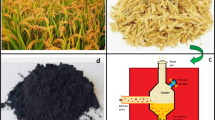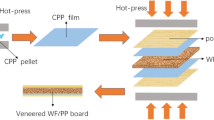Abstract
Wood and metals are replaced by fiber reinforced plastic composites due to many reasons, mainly because their various properties like light weight behavior, high strength to weight ratio, noncorrosive nature and stiffness. Petroleum-based fibers are substituted with bio-based fibers in regard to environmental concerns. Raw fiber displays low-specific strength along with light density, and also the handling and recycling processes are found to be simple. In the area of composites, various advanced materials are produced every day. This paper presents the worn surface morphological characterization of NaOH-treated chopped abaca fiber reinforced epoxy composites. The specimens analyzed after the pin on disc (POD) test exhibited tribo-morphology characterization. The chopped abaca fiber reinforced epoxy composites were fabricated by varying the fiber volume fraction (10 wt%, 15 wt%, 20 wt%, and 25 wt%) using the compression moulding technique. The structure of the worn surfaces and fiber matrix interface were evaluated using a scanning electron microscope (SEM). The outcomes revealed that the presence of abaca fibers in the composites improved the morphological characterization of the neat epoxy. SEM micrographs of 25 wt % of abaca fiber-epoxy composites showed better worn properties when compared with other composite specimens.






Similar content being viewed by others
Data Availability
The data will be available on request.
References
Mahesh D, Kowshigha KR, Raju NV, Aggarwal PK (2019) Characterization of banana fiber-reinforced polypropylene composites. J Indian Acad Wood Sci 1-8.
Rajeshkumar G, Hariharan V, Indran S, Sanjay MR, Siengchin S, Maran JP, Karuppiah P (2020) Influence of Sodium Hydroxide (NaOH) Treatment on Mechanical Properties and Morphological Behaviour of Phoenix sp. Fiber/Epoxy Composites. J Polym Environ 1-10
Siva R, Valarmathi TN, Palanikumar K, Samrot AV (2020) Study on a Novel natural cellulosic fiber from Kigelia africana fruit: characterization and analysis. Carbohydr Polym 116494
Suresh S, Sudhakara D, Vinod B (2020) Investigation on industrial waste eco-friendly natural fiber-reinforced polymer composites. J Bio-Tribo-Corrosion 6(2):1–14
Suresh S, Sudhakara D (2019) Investigation of mechanical and tribological properties of red mud-reinforced particulate polymer composite. J Bio-and Tribo-Corros 5(4):87
Alhijazi M, Zeeshan Q, Safaei B, Asmael M, Qin Z (2020) Recent developments in palm fibers composites: a review. J Polym Environ 1-26
Abhilash SS, Singaravelu DL (2020) Effect of fiber content on mechanical and morphological properties of bamboo fiber-reinforced linear low-density polyethylene processed by rotational molding. Transact Indian Instit Metals 1-6
Hughes M (2012) Defects in natural fibres: their origin, characteristics and implications for natural fibre-reinforced composites J Mater Sci 47(2):599e609
Thakur VK, Singha AS, Thakur MK (2012) Green composites from natural fibers: mechanical and chemical aging properties. Int J Polym Anal Charact 17:401–407
Bhowmic M, Mukhopadhyay S, Alagirusamy R (2012) Mechanical properties of natural fibre-reinforced composites. Textile Progress 44:85–140
Pickering KL, Aruan Efendy MG, Le TM (2016) A review of recent developments in natural fibre composites and their mechanical performance. Composites: Part A 83:98–112
Arumugam C, Arumugam S, Muthusamy S (2020) Mechanical, thermal and morphological properties of unsaturated polyester/chemically treated woven kenaf fiber/AgNPs@ PVA hybrid nanobiocomposites for automotive applications. J Mater Res Technol
Reddy KO, Maheswari CU, Reddy DJP, Rajulu AV (2009) Thermal properties of Napier grass fibers. Mater Lett 63(27):2390e2392
Gbadeyan OJ, Bright G, Sithole B, Adali S (2020) Physical and morphological properties of snail (Achatina Fulica) shells for beneficiation into biocomposite materials. J Bio-and Tribo-Corros 6(2):35
Klingler A, Bajpai A, Wetzel B (2018) The effect of block copolymer and core-shell rubber hybrid toughening on morphology and fracture of epoxy-based fibre reinforced composites. Eng Fracture Mech 203:81–101
Jagtap S, Rao VS, Ratna D (2012) Preparation of flexible epoxy/clay nanocomposites: effect of preparation method, clay modifier and matrix ductility. J Reinf Plast Compos 32:183–196
Dinesh,T, Kadirvel A, Hariharan P (2020) Thermo-mechanical and wear behaviour of surface-treated pineapple woven fibre and nano-silica dispersed mahua oil toughened epoxy composite. Silicon 1-10
Bledzki AK, Gassan J (1999) Composites reinforced with cellulose based fibres. Prog Polym Sci 24:221–274
Rajesh G, Prasad AVR (2013) Effect of fibre loading and successive alkaline treatments on tensile properties of short jute fibre reinforced polypropylene composites. Adv Mater Manuf Charact 3:528–532
Udhayasankar R, Karthikeyan B (2019) Processing of cardanol resin with CSP using compression molding technique. Mater Manuf Processes 34(4):397–406
Balaji A, Karthikeyan B, Swaminathan J (2019) Comparative mechanical, thermal, and morphological study of untreated and NaOH-treated bagasse fiberreinforcedcardanol green composites. Adv Compos Hybrid Mater 2(1):125–132
Lai WL, Mariatti M (2008) The properties of woven betel palm (Areca catechu) reinforced polyester composites. J Reinf Plast Compos 27:925–935. https://doi.org/10.1177/0731684407085876
Vignesh, Nataraj et.al “wear behaviour of coconut shell powder and coir fibre reinforced polyester composites”. IOSR J Mech Civil Eng (IOSR JMCE) e-ISSN: 2278-1684, p-ISSN: 2320-334XPP 53-57.
Prasad PR, Prakash JN, Manjunath LH, Reddy PV (2020) Physical and wear properties of UHMWPE fabric reinforced epoxy composites. Int J Automot Eng 17(1):7577–7586
Mohanty A, Khan M, Hinrichsen G (2000) Influence of chemical surface modification on the properties of biodegradable jute fabrics- polyester amide composites. Compos Part A Appl Sci Manuf 31(2):143150
Bledzki AK, Faruk O, Sperber VE (2006) Cars from biofibers. Macromol. Mater. Eng. 291:283–293
Huang G (2009) Tensile behaviours of the coir fibre and related composites after NaOH treatment. Mater Des 30(9):3931–3934
Ramadevi P, Dhanalakshmi S, Ranganagowda RP, Basavaraju B, Pramod VB, Srinivasa CV (2014) Surface modification of abaca fiber by benzenediazonium chloride treatment and its influence on tensile properties of abaca fiber reinforced polypropylene composites. Cieˆnc Tecnol dos Materiais 26(2):142–149
Pothan LA, Oommen Z, Thomas S (2003) Dynamic mechanical analysis of banana fiber reinforced polyester composites. Compos Sci Technol 63:283–293
Pothan LA, Thomas S (2003) Polarity parameters and dynamic mechanical behaviour of chemically modified banana fiber reinforced polyester composites. Compos Sci Technol 63:1231–1240
Pothan LA, Neelakantan NR, Rao B, Thomas S (2004) Stress relaxation behavior of banana fiber-reinforced polyester composites. J Reinf Plast Compos 23:153–166
Pothan LA, Thomas S (2004) Effect of hybridization and chemical modification on the water-absorption behaviour of banana fiber-reinforced polyester composites. J Appl Polym Sci 91:3856–3865
Wambua P, Ivens J, Verpoest I (2003) Natural fibres: can they replace glass in fibre reinforced plastics? Compos Sci Technol 63:1259–1264. https://doi.org/10.1016/S0266-3538(03)00096-4
Alamri H, Low IM, Alothman Z (2012) Mechanical, thermal and microstructural characteristics of cellulose fibre reinforced epoxy/organoclay nanocomposites. Compos B 43:2762–2771. https://doi.org/10.1016/j.compositesb.2012.04.037
Murali Mohan Rao K, Mohana Rao K, Ratna Prasad AV (2010) Fabrication and testing of natural fibre composites: vakka, sisal, bamboo and banana. Mater Des 31:508–513. https://doi.org/10.1016/j.matdes.2009.06.023
Wang F, Shao J, Keer LM et al (2015) The effect of elementary fibre variability on bamboo fibre strength. Mater Des 75:136–142. https://doi.org/10.1016/j.matdes.2015.03.019
Essabir H, Bensalah MO, Rodrigue D et al (2016) Structural, mechanical and thermal properties of bio-based hybrid composites from waste coir residues: fibers and shell particles. Mech Mater 93:134–144. https://doi.org/10.1016/j.mechmat.2015.10.018
Essabir H, Boujmal R, Bensalah MO et al (2016) Mechanical and thermal properties of hybrid composites: oil-palm fiber/clay reinforced high density polyethylene. Mech Mater 98:36–43. https://doi.org/10.1016/j.mechmat.2016.04.008
Wang F, Li X, Zhang J et al (2016) Micromechanical modelling of the progressive failure in unidirectional composites reinforced with bamboo fibres. Mech Mater 94:180–192. https://doi.org/10.1016/j.mechmat.2015.12.006
Koronis G, Silva A, Fontul M (2013) Green composites: a review of adequate materials for automotive applications. Compos Part B 44:120–127
Baltazar-y-Jimenez A, Bistritz M, Schulz E, Bismarck A (2008) Atmospheric air pressure plasma treatment of lingo cellulosic fibres: impact on mechanical properties and adhesion to cellulose acetate butyrate. Compos Sci Technol 68:215–227
Munawar SS, Umemura K, Kawai S (2006) Characterization of the morphological physical, and mechanical properties of seven non wood plant fiber bundles. Jpn Wood Res Soc 53:108–113
Lewin M (2007) Handbook of Fiber Chemistry, 3rd edn. CRC Press, Boca Raton
Reddy PV, Reddy RS, Rajendra Prasad P, Mohana Krishnudu D, Reddy RM, Rao HR (2020) Evaluation of mechanical and wear performances of natural fiber reinforced epoxy composites. J Nat Fibers 1-14
Balaji A, Purushothaman R, Udhayasankar R, Vijayaraj S, Karthikeyan B (2020) Study on mechanical, thermal and morphological properties of banana fiber-reinforced epoxy composites. J Bio-and Tribo-Corros 6:1–10
Chandramohan D, Murali B, Vasantha-Srinivasan P, Kumar SD (2019) Mechanical, moisture absorption, and abrasion resistance properties of bamboo–jute–glass fiber composites. J Bio-and Tribo-Corros 5(3):66
Kurien RA, Selvaraj DP, Sekar M, Koshy CP (2020). Green composite materials for green technology in the automotive industry. In: IOP Conference Series: Materials Science and Engineering (Vol. 872, No. 1, p. 012064). IOP Publishing.
Funding
Centre for Engineering Research and Development (CERD), APJ Abdul Kalam Technological University (APJAKTU) (KTU/RESEARCH 2/4068/2019).
Author information
Authors and Affiliations
Contributions
RAK: investigation, data curation, writing—original draft, DPS: supervision, review & editing, CPK: conceptualization, methodology, validation.
Corresponding author
Ethics declarations
Conflict of interest
The authors declare that they have no conflict of interest.
Ethical Approval
Approved by the Ethical Committee of Karunya Institute of Technology and Sciences, Approval Number DC083/2016.
Informed Consent
All the named authors involved in the paper had read it before its submission to publication and confirmed the approval of the complete content.
Additional information
Publisher's Note
Springer Nature remains neutral with regard to jurisdictional claims in published maps and institutional affiliations.
Rights and permissions
About this article
Cite this article
Kurien, R.A., Selvaraj, D.P. & Koshy, C.P. Worn Surface Morphological Characterization of NaOH-Treated Chopped Abaca Fiber Reinforced Epoxy Composites. J Bio Tribo Corros 7, 31 (2021). https://doi.org/10.1007/s40735-020-00467-3
Received:
Revised:
Accepted:
Published:
DOI: https://doi.org/10.1007/s40735-020-00467-3




